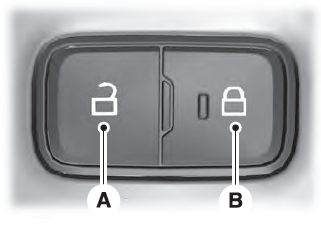Lincoln Aviator 2020-2026 Service Manual / Body and Paint / Body and Paint / Seatbelt Systems / Removal and Installation - Second Row Center Seatbelt Retractor
Lincoln Aviator: Seatbelt Systems / Removal and Installation - Second Row Center Seatbelt Retractor
Removal
NOTE: Removal steps in this procedure may contain installation details.
-
Remove the second row center seat.
Refer to: Second Row Center Seat (501-10B Second Row Seats, Removal and Installation).
-
Remove the bolt and position the second row center seatbelt anchor aside.
Torque: 30 lb.ft (40 Nm)
.jpg) |
-
Remove the second row center seatbelt guide bezel.
-
Remove the cover.
-
Remove the screws.
-
Release the bezel guide pins.
-
Route the seatbelt through the bezel.
-
Remove the cover.
.jpg) |
-
Lift the second row center seat backrest cover.
-
Remove the child safety seat tether anchor bezel.
-
Release the J-clip.
-
Unzip the backrest cover.
-
Lift the backrest cover.
-
Remove the child safety seat tether anchor bezel.
.jpg) |
-
Release the hook-and-loop retainers and position the second row center seat backrest cover aside.
.jpg) |
-
If equipped with second row seat armrest.
Remove the second row seat armrest.
Refer to: Second Row Seat Armrest (501-10B Second Row Seats, Removal and Installation).
-
Remove the second row center seatbelt retractor bolt.
Torque: 30 lb.ft (40 Nm)
.jpg) |
-
Route the second row center seatbelt anchor through the backrest cover.
.jpg) |
-
Lift the second row center seat backrest cover and foam.
.jpg) |
-
Remove the second row center seatbelt retractor.
.jpg) |
Installation
NOTE: During installation, make sure the seatbelt webbing is not twisted and the seatbelts and buckles are accessible to the occupants.
-
To install, reverse the removal procedure.
-
Check the seatbelt system for correct operation.
Refer to: Seatbelt Systems (501-20A Seatbelt Systems, Diagnosis and Testing).
 Removal and Installation - Second Row Center Seatbelt Buckle
Removal and Installation - Second Row Center Seatbelt Buckle
Removal
NOTE:
Removal steps in this procedure may contain installation details.
Remove the second row center seat.
Refer to: Second Row Center Seat (501-10B Second Row Seats, Removal and Installation)...
 Removal and Installation - Second Row Seatbelt Buckle
Removal and Installation - Second Row Seatbelt Buckle
Removal
NOTE:
Removal steps in this procedure may contain installation details.
NOTE:
LH (left-hand) seat shown, RH (right-hand) seat similar.
NOTE:
Single seat shown, captain chair similar...
Other information:
Lincoln Aviator 2020-2026 Service Manual: Removal and Installation - Radio Transceiver Module (RTM)
Removal NOTE: Removal steps in this procedure may contain installation details. NOTE: If installing a new module, it is necessary to upload the module configuration information to the diagnostic scan tool prior to removing the module. This information must be downloaded into the new module after installation...
Lincoln Aviator 2020-2026 Service Manual: General Procedures - Spark Plug Inspection
Inspection NOTE: Dropped spark plugs should always be discarded. Unfired An unfired spark plug should appear very clean with a pure nickel finish to the threads and ground strap. The center electrode ceramic insulator surface is often a matte or dull finish and pure white in color...
Categories
- Manuals Home
- Lincoln Aviator Owners Manual
- Lincoln Aviator Service Manual
- Disabling Auto-Start-Stop
- Fuel Quality
- Opening and Closing the Hood
- New on site
- Most important about car
Locking and Unlocking the Doors from Inside

Locking the Doors
Press the lock switch on the door interior trim panel. The doors can no longer be released using the exterior door handle switches and the luggage compartment locks.
Copyright © 2026 www.liaviator2.com
